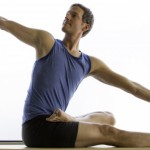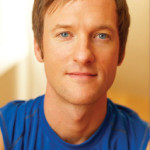Whether it’s your ability to do multiplication in your head, recite a poem, or ride a bike, there is truth to the adage “use it, move it or lose it”. What we stop using, we stop having access to as our age progresses. We experience this in physical ways all the time in yoga: lots of students will say they could do a handstand as a kid, but they’re scared of the prospect now. What has happened? What happens to your muscles as you age, and what happens to your outlook?
 It’s true that your VO2 max, a measure of your endurance and power declines starting in your 30s or 40s and then drastically drops off. Even tremendously dedicated athletes are no exception to this experience, although one study on the phenomenon of muscle loss demonstrated that the 70-plus group was still fitter than the average sedentary 35-year-old… so don’t discount your grandpa if he jogs every day!
It’s true that your VO2 max, a measure of your endurance and power declines starting in your 30s or 40s and then drastically drops off. Even tremendously dedicated athletes are no exception to this experience, although one study on the phenomenon of muscle loss demonstrated that the 70-plus group was still fitter than the average sedentary 35-year-old… so don’t discount your grandpa if he jogs every day!
Where decline is particularly noticeable though is the strength and control of muscle groups that are not used. So if grandpa jogs every day, an MRI may reveal strong, healthful muscle tissue in his legs, but his shoulders would appear no different than a sedentary man his age.
If we want to maintain the range of control and health of the muscle we have, or develop more (it’s always possible!), we need to commit to a regimen of diverse movement. It’s fantastic if you’re still going for a jog in your golden years, but getting on your yoga mat and strengthening your shoulders in downward facing dog is an excellent compliment to your routine. The more diverse the movements you take, the less injury and muscle loss you will experience.
Of course, there’s also the discomfort or fear of new things, but research actually shows that most people get less conservative with time. They’re open to the new and interesting concepts that yoga has to offer like meditation, philosophy and spirituality, but physically, it’s understandable they may be reticent to try hopping upside down into a handstand for fear of injury.
When students come to the yoga mat for the first time as seniors, they’ve had a lifetime of experience doing things in a way that makes them feel comfortable and safe. Injury is also a possibility in any yoga practice, regardless of the age, so it’s important that students practice in a highly attuned way and teachers provide safe options throughout their class. There’s no need for senior students to avoid all-levels classes so long as there’s an open dialogue about creating opportunities for modifications.
This October, PranaShanti is welcoming the tremendously knowledgeable and skillful Jason Crandell to the centre  for the first time. Jason’s smart, compassionate approach to yoga includes advanced postures like arm balances and headstands, but each sequence logically builds toward these postures and each student will have an iteration they can do. The practice is accessible, and Jason’s commitment to taking practice at a manageable pace means that no one is overwhelmed and distracted, increasing the risk of injury. He likes to say that “it’s more important to have a clear practice that gets some things really well done, then do everything less thoroughly”.
for the first time. Jason’s smart, compassionate approach to yoga includes advanced postures like arm balances and headstands, but each sequence logically builds toward these postures and each student will have an iteration they can do. The practice is accessible, and Jason’s commitment to taking practice at a manageable pace means that no one is overwhelmed and distracted, increasing the risk of injury. He likes to say that “it’s more important to have a clear practice that gets some things really well done, then do everything less thoroughly”.
Whether you’re a yoga teacher or a student, his Master Class weekend is one where you’ll really learn about practicing “Power, Precision + Mindfulness” – the core concepts of the workshops – in your teaching and your yoga. It’s a gift to yourself as your yoga practice takes you through your years, and help you be a more informed teacher for your students.

Awesome blog posted. Thank you for sharing it.